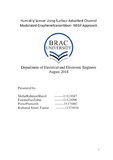Humidity sensor using surface adsorbed channel modulated GrapheneNanoribbon : NEGF approach
Abstract
Flexible, highly sensitive and low cost humidity sensors are highly enviable in future generation sensor technology. As a result of recent year’s research conducted concerning the applicability in gas and humidity sensors, graphene is reported to be an appropriate sensing material for this purpose. The inimitable structural, mechanical and electronic properties of graphene has attracted extensive attention of scientists, therefore the successful synthesis of novel two-dimensional (2D) graphene and the experimental observation of Dirac fermions in unpatterned graphene devices has been increasing rapidly. This thesis describes simulation based study of humidity sensing ability of patterned graphene adsorbing vapour (H2O) and investigate electronic and quantum transport properties of these system such as Device Density of States ( DDOS ), Electrostatic Effective Potential (EDP), Conductivity (G) and Current-Voltage (I-V) characteristics. Transport simulation is based on Non-equilibrium Green’s Function (NEGF) formalism. In our thesis, we have considered three cases such as semiconducting grapheme nanoribbon (N=10), metallic grapheme nanoribbon (N=11) and cascade hetero-graphene nanoribbon, where sensing medium is semiconducting GNR (N=10) and contact is metallic GNR (N=11) to realize the effect of H2O adsorption on it. We have calculated the highest number of H2O molecules that can be absorbed on corresponding to the area of GNR to get maximum current. Later on we propose a simple schematic model to characterize device performance which incorporates the effect of metal contact resistance with GNR.

